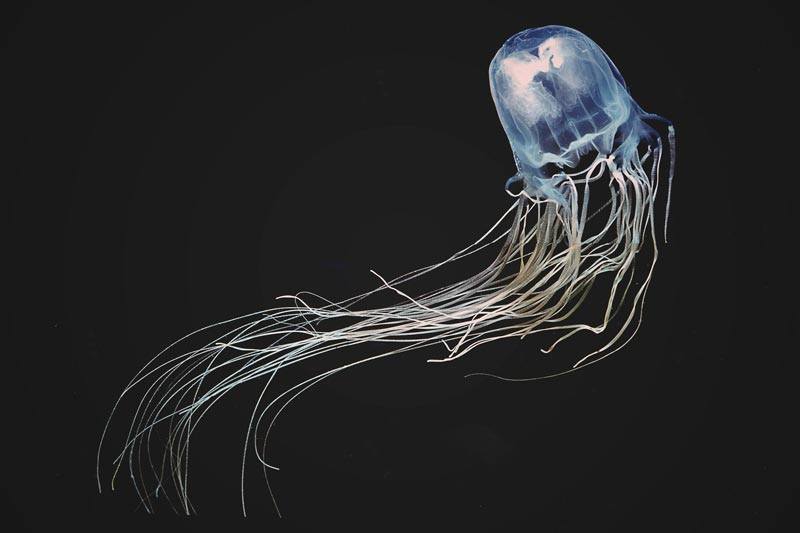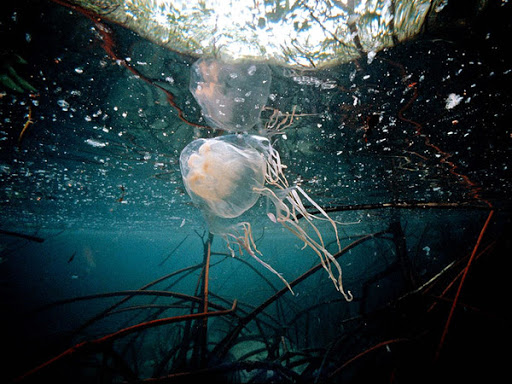Jellyfish are fascinating living beings, they can live in the ocean only by waving their gelatinous bell-shaped bodies, although they are very venous and according to their species they can be lethal, today you will learn everything about jellyfish jellyfish or sea wasp.

It is a jellyfish that is attributed the scientific name of "Chironex fleckeri", it is in the category of the most lethal jellyfish in the world, since they are capable of killing a human being with just a touch. The distribution of these jellyfish in the world starts from the seas of Australia and surrounding areas to the eastern Indian Ocean and the Pacific, almost no species of this jellyfish have been found in other parts of the world.
There are many people who believe that jellyfish are harmless beings because of their transparent and calm appearance, although this particular species is the most poisonous known in the jellyfish family today. The sting of one of these can make a person lose consciousness only because of the intense pain it produces in the body, without even the poison beginning to take effect.
The appearance of this jellyfish makes it almost impossible to detect in time, especially for those swimmers who are on the beaches of Australia taking a bath since they tend to roam shallow water at any time of day.
Features
Unlike the other jellyfish, this one has a square body (not round), although it has a transparent color that does not allow its prey to be detected in time, a perfect camouflage without a doubt. When night comes they usually have a certain brightness in the water.
The tentacles of a jellyfish or sea wasp can measure up to three (3) meters in length and are made up of five billion microscopic stingers, these being the ones used to inject their venom, you do not want to be stung by one of them. are.
Something that other jellyfish undoubtedly do not have are the four groups that consist of 20 eyes, since most of the jellyfish that exist do not have eyes, therefore they are blind. However, it has not been possible to fully verify whether these jellyfish with eyes have the ability to process an image to carry out some action such as hunting, although it seems unlikely since they do not have a fully developed central nervous system.
Veneno
They have one of the most powerful poisons in the world like that of a banana spider, being that the jellyfish or sea wasp needs only 1,4 milligrams of poison to kill a human in 5 minutes or complicate their health for life. If we take all the poison that the jellyfish has in its body, up to 50 people could be killed.
According to various scientific studies that could be done on these jellyfish, their venom becomes more powerful as they age, considering that when they are younger they only have venom in 5% of the stinging cells, while when they reach maturity they are already 50% developed and can attack larger prey without any problem.
The effect of the poison on humans is one of the worst things that exist, once the jellyfish has had contact with the skin of a human being with the tentacles, reddish lesions begin to be seen. If she has been able to inject enough of the poison to be lethal, the affected part will begin to swell and after 20 minutes a syndrome called "irukandji" will occur.
This is a syndrome that causes excruciating pain throughout the body, there is also a doubling of blood pressure and the heart rate rises severely. Once this happens, the person suffers a cardiac arrhythmia that causes death.
But if the jellyfish has not injected enough poison to kill the person, intense pain lasts up to 2 days. The person should immediately wash the area with vinegar, where they have been bitten, although they should be transferred as quickly as possible to a hospital to receive the appropriate treatment.
Reproduction of the Sea Wasp
The reproduction of a jellyfish or sea wasp begins in the spring season when they are found in calm rivers to find their partner in freshwater sources and it is there that they lay their eggs in the water or release the sperm so that they can take place. to fertilization. Once the eggs have been expelled, larvae are produced that settle on any rigid surface to become a polyp.
These polyps are very small, they can even measure a couple of millimeters but they already have two of their tentacles developing and they use them to adhere to the rigid surface to protect themselves. After this polyp has sprouted, it transforms into a young jellyfish that begins its life until reaching sexual maturity, then leaves the river to go to the sea and develop as an adult jellyfish or sea wasp. The reproduction of the sea wasp ends in the death of the same at the moment of releasing the sperm and the ovules, so it is not responsible for raising its eggs because they do not have enough life expectancy, since they only arrive around one (1) year.
Behavior of the jellyfish or sea wasp
The behavior of these jellyfish is different from that of other species, since they are always swimming in the sea current, something that other species that simply float and drift in the ocean current do not do. Likewise, the jellyfish or sea wasp positions itself at the bottom of the sea and stays there if there is no threat that could affect it.
It is believed that they have this behavior at the bottom of the sea since they need to recover the energy that they have spent swimming for so long in the sea. These feed during the day and move slowly through the seas until they go to the bottom for a short rest.
When the sea current is very strong, they go down to the bottom of the sea where it is calmer and wait for the current to calm down to swim closer to the surface again. In general, the stings to human beings are not done intentionally, since due to their appearance, human beings do not detect them and are accidentally bitten.


